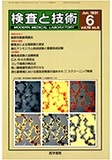Japanese
English
- 有料閲覧
- Abstract 文献概要
CarnotとDeflandre(Fr Acad Sci 1906;148:384)がいわゆる“造血素”としての活性を証明したというよりは示唆したエリスロポエチン(EPO)は,造血成長因子として記述された最初のホルモンである.EPOはJacobsenらによって,1950年代にアメリカ合衆国において再発見された.それ以来,その生理的重要性は客観的に研究され,そして,その生化学的,遺伝子学的同定はすでに完了された.最近,EPOは数種類の重症貧血において臨床的治験がなされてきた.
EPO濃度はバイオアッセイで測定するのは常に困難で,時間と費用のかかるものであった.例えば,多血症マウス(輸血または低酸素状態による)への59Fe(放射性鉄)の取り込み,in vitroでの新生ラットの浮遊肝細胞への59Feの取り込みや,in vitroでの正常ないし赤白血病細胞系の赤血球コロニーの成長など(による測定方法)である.初期のラジオイムノアッセイ(RIA)は,主に抗原精製が不十分なために不完全なものであった.
Erythropoietin (EPO) is the first hormone described as a hematopoietic growth factor, even though Carnot and Deflandre (Fr-Acad Sci 1906; 148: 384) suggested, rather than demonstrated, the activity of the so-called “hematopoietine.” EPO was rediscovered in the USA in the 1950s by Jacobsen et al.; its physiological significance has been objectively studied and its biochemical and genetic identification has been completed. Recently, EPO has been used for clinical trials in some types of severe anemia.
Determining EPO concentration by bioassays has always beendifficult, long, and expensive: incorporation of 59 Fe into Polycythemic (post-transfusion, or exhypoxic) mice, in vitro incorporation of 59Fein a suspension of liver cells from newborn mice, or in vitro growth oferythrocyte colonies of normal or erythroleukemic cell lines. Theearly radioimmunoassays (RIAs) developed were faulty, mainlybecause of incomplete purification of the antigen.
Copyright © 1991, Igaku-Shoin Ltd. All rights reserved.


